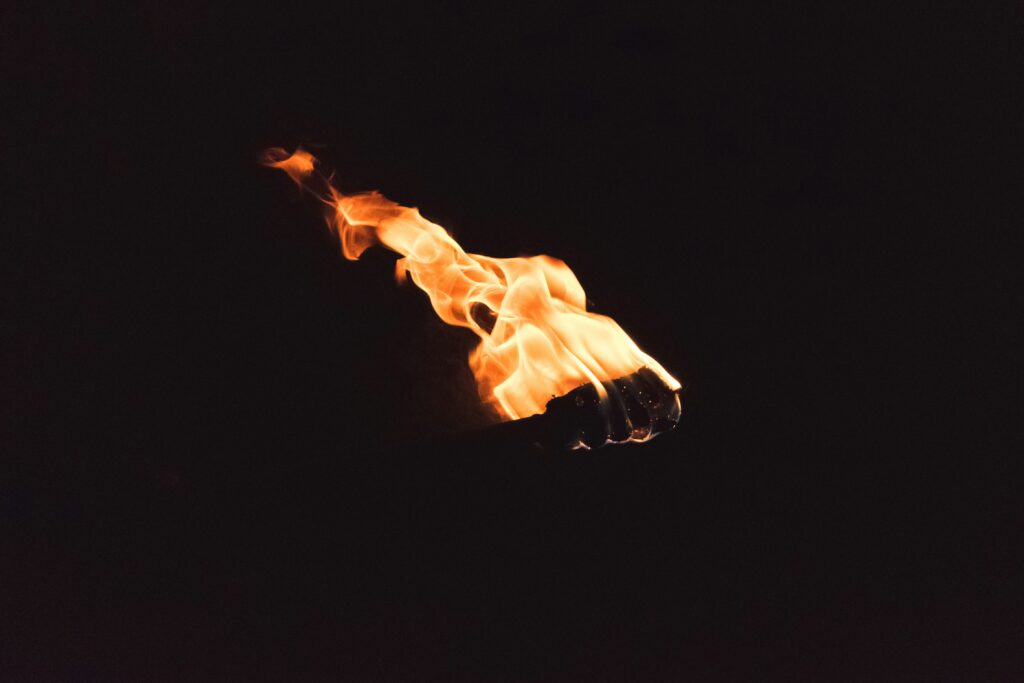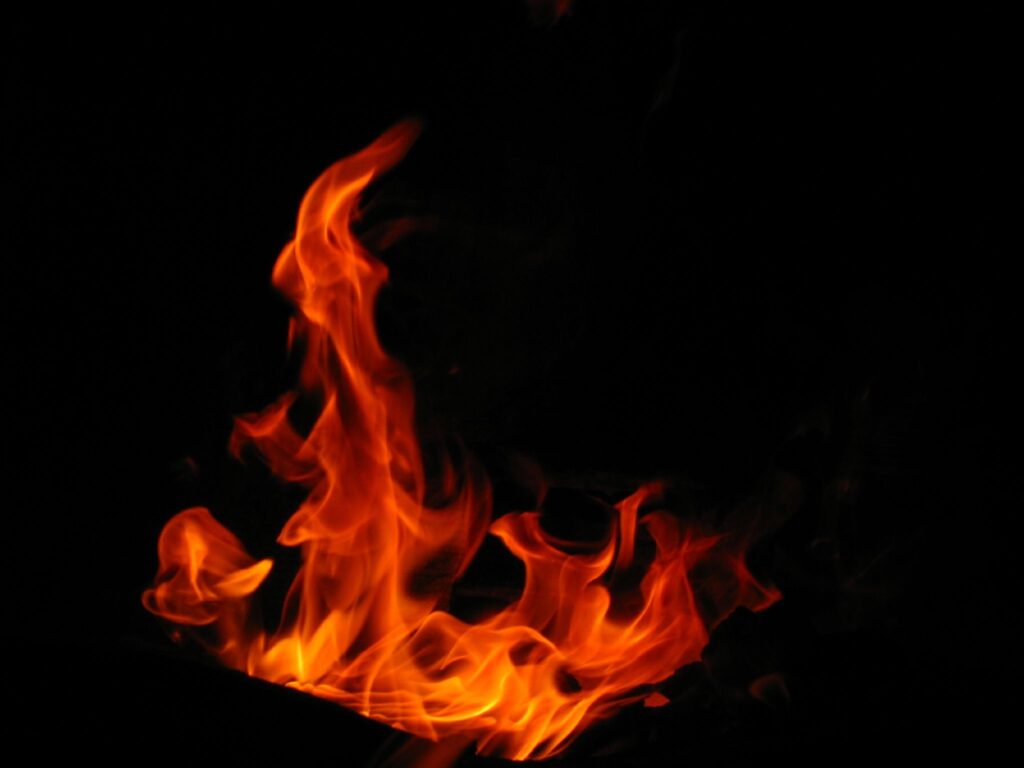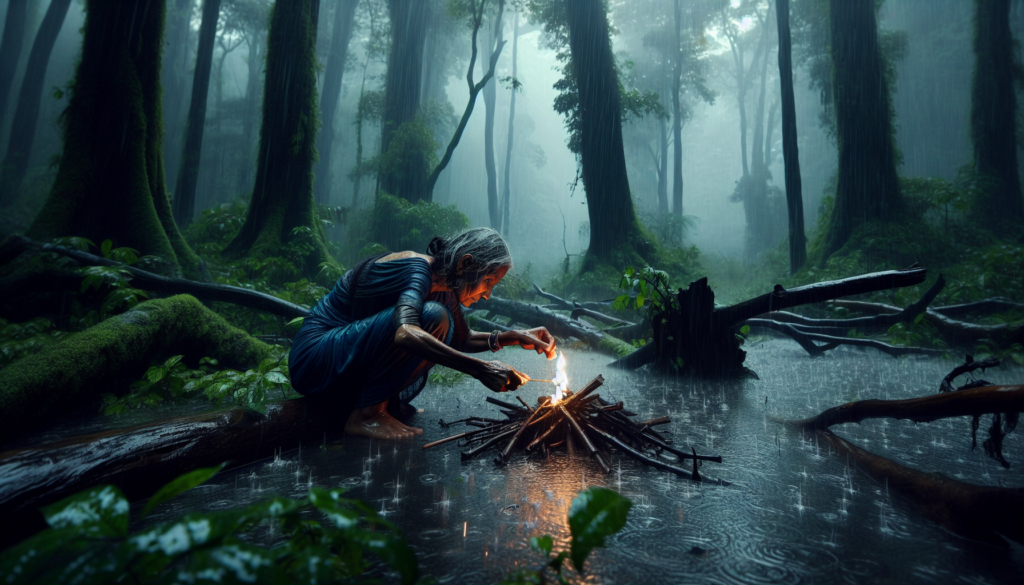Imagine yourself in the middle of a wet forest, rain pouring down relentlessly, and you shivering with cold as the darkness settles in. You desperately need a fire to warm yourself up and provide some comfort, but the wet conditions seem to be working against you. Fear not, my friend, for in this article, you will discover some useful tips and tricks on how to build a fire even in the wettest of conditions. So, grab your raincoat, put on a brave face, and let’s embark on this adventure together!

Materials Needed
To build a fire in wet conditions, you will need the following materials:
Dry tinder
Dry tinder is crucial for starting a fire, especially in wet conditions. You can gather dry leaves, small twigs, or any other dry plant material that easily ignites.
Kindling
Kindling consists of small sticks or branches that are slightly larger than your tinder. It helps sustain the initial flame and ignite the larger pieces of firewood.
Firewood
Firewood provides the main fuel source for your fire. Look for dry firewood that has been sheltered from rain or moisture.
Waterproof matches or lighter
In wet conditions, it’s important to have waterproof matches or a reliable lighter. These tools will ensure that you can ignite your fire even in damp or rainy conditions.
Firestarter
A firestarter can be useful, especially in wet conditions. It’s a highly flammable material, such as cotton balls soaked in wax or commercially available fire starters, that helps ignite your tinder and kindling more easily.
Location Selection
Choosing the right location for your fire is essential, especially in wet conditions. Here are a few tips to help you select the ideal spot:
Avoid low-lying areas
Low-lying areas tend to accumulate moisture, making it challenging to start and maintain a fire. Try to find higher ground where the ground is less saturated.
Look for natural shelters
Natural shelters, such as overhanging rocks or dense tree canopies, can provide much-needed protection from rain and wind. These shelters can help keep your fire dry and prevent the flames from being extinguished.
Check for high ground
High ground allows better airflow around your fire, reducing the risk of rainwater accumulating near the fire site. This can make a significant difference in maintaining a stable fire even in wet conditions.
Preparing the Fire Site
Before you start building your fire, it’s crucial to prepare the fire site properly. Follow these steps to ensure a well-prepared fire site:
Clear the area
Clearing the area around your fire site is essential for safety. Remove any leaves, branches, or other flammable materials that could catch fire and cause the flames to spread.
Create a platform
To keep your fire off the wet ground, create a platform using rocks or logs. This will help prevent moisture from seeping into your fire and make it easier to start and maintain.
Build a windbreak
Building a windbreak is crucial, especially in wet and windy conditions. Use rocks or logs to construct a barrier that will shield the fire from gusts of wind and help maintain a steady flame.
Gather firewood and kindling
Before you start building your fire, gather enough firewood and kindling to sustain the fire. Look for dry wood that has been sheltered from rain or moisture. Having ample fuel readily available will make the fire-building process much smoother.
Tinder Preparation
When building a fire in wet conditions, it’s essential to carefully prepare your tinder. Here are some tips to ensure your tinder is as dry as possible:
Gather dry tinder
Look for dry tinder materials, such as dry leaves, small twigs, or grass, that have not been exposed to moisture. These materials ignite easily and help kickstart your fire.
Make your own tinder
If you can’t find dry tinder, you can create your own by shaving thin, dry pieces of wood or using a knife to create fine, flammable shavings. This homemade tinder can be highly effective at catching fire, even in wet conditions.
Use accelerants sparingly
While accelerants like lighter fluid or gasoline may seem like a quick solution in wet conditions, they can be dangerous and cause uncontrollable flare-ups. It’s best to rely on natural tinder and kindling to ignite your fire safely.
Building the Fire
Now that you have prepared the fire site and gathered dry tinder, it’s time to start building the fire. Follow these steps to build a fire that can withstand wet conditions:
Lay down a base of tinder
Start by laying down a base of dry tinder on the fire site platform. This will serve as the foundation for your fire and ensure a good start.
Arrange kindling in a tepee shape
Arrange your kindling in a tepee shape above the tinder, leaving an opening where you can ignite the fire. The tepee shape allows for good airflow and helps the fire spread from the tinder to the kindling.
Build a larger firewood structure
As the kindling catches fire, gradually add larger pieces of firewood to the structure. Make sure to leave openings for oxygen flow to sustain the flames.
Light the tinder carefully
Using your waterproof matches or lighter, carefully light the tinder at the base of the fire structure. Focus on ensuring that the flame ignites the tinder effectively to start the fire.
Lighting the Fire
When lighting a fire in wet conditions, it’s crucial to take extra precautions to protect the flame from wind and rain. Follow these tips to light your fire successfully:
Use waterproof matches or a lighter
Ensure that you have waterproof matches or a reliable lighter specifically designed for wet conditions. These tools will help guarantee that you can ignite your fire despite the dampness.
Protect the flame from wind and rain
Shield the flame by cupping your hand around it or using a windproof lighter to prevent gusts of wind from extinguishing it. Additionally, shelter the flame from rain by using an umbrella or other protective covering.
Add more tinder if necessary
If the flame struggles to ignite the kindling, add more dry tinder to increase the heat. This additional tinder will help create a stronger flame and eventually catch the kindling on fire.

Maintaining the Fire
Once your fire is successfully burning, maintaining it in wet conditions requires some extra attention. Here are some tips for keeping your fire going:
Add firewood progressively
Continuously add firewood to the fire, gradually increasing the size of the logs. This ensures that you maintain a steady heat source and prevents the fire from dying out.
Control airflow
Regulate the airflow around the fire by adjusting the position of the logs and windbreak. Building a controlled and enclosed space for the fire helps maintain optimal conditions for consistent burning.
Keep firewood dry
Always store your firewood in a dry location, away from moisture. Wet firewood can be challenging to burn and may extinguish the fire or produce excessive smoke.
Maintain a safe distance
Ensure you maintain a safe distance from the fire to avoid any accidents or burns. Pay attention to the invenient materials and surroundings and keep children and pets away from the fire.
Emergency Fire Lighting
In emergency situations or when facing particularly challenging conditions, it’s essential to have alternative methods to light a fire. Here are some tips for emergency fire lighting:
Use dry clothing
If you find yourself without traditional fire-starting tools or tinder, you can use pieces of dry clothing, such as cotton or wool, to serve as makeshift tinder. The fabric’s fibers can catch fire even in damp conditions.
Shelter the firestarter under a jacket
To protect your firestarter from rain or wind, place it inside a ziplock bag or wrap it in a waterproof material. Secure the firestarter beneath your jacket or in another warm place to keep it dry and ready for use.
Use natural materials as tinder
If all else fails, look for natural materials in your surroundings that can serve as tinder. Dry grass, pine needles, or dried flower stalks can provide flammable options even in wet conditions.

Tips and Precautions
When building a fire in wet conditions, it’s important to keep the following tips and precautions in mind:
Be prepared with backup tools
Always have multiple sets of waterproof matches and lighters on hand as backup. It’s better to be over-prepared than to risk being unable to start a fire in an emergency situation.
Stay cautious of fire hazards
While building a fire, be aware of flammable materials and surroundings. Clear a significant area around the fire site to prevent accidental fires from spreading.
Don’t leave the fire unattended
Never leave a fire unattended, particularly in wet conditions. Even a seemingly controlled fire can become unpredictable due to changing weather conditions or sudden wind gusts.
Conclusion
Building a fire in wet conditions can be a challenging but essential skill to have. With practice and experience, you can improve your fire-building skills and adapt to various conditions. By staying knowledgeable about the conditions and surroundings, as well as following the steps outlined above, you can successfully build a fire even when faced with dampness or rain. Remember to prioritize safety, be prepared, and enjoy the warmth and comfort that a well-built fire can provide.



